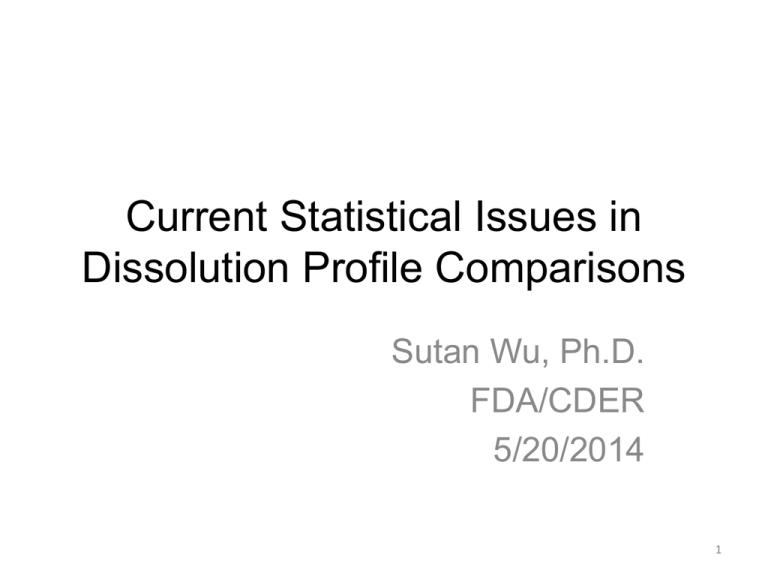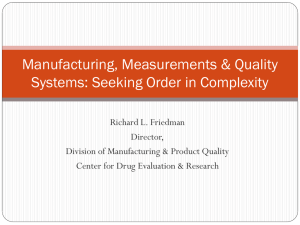Current Statistical Issues in Dissolution Profile
advertisement

Current Statistical Issues in
Dissolution Profile Comparisons
Sutan Wu, Ph.D.
FDA/CDER
5/20/2014
1
Outlines:
• Background of Dissolution Profile Comparisons
• Current Methods for Dissolution Profile
Comparisons
• Current Statistical Concerns
• Simulation Cases
• Discussions
2
Disclaimer:
The presented work and views in this talk represents
the presenter’s personal work and views, and do not
reflect any views or policy with CDER/FDA.
3
Backgrounds:
Dissolution profile comparison: why so important?
Extensive applications throughout the product development process
Comparison between batches of pre-change and post-change under
certain post-change conditions
e.g.: add a lower strength, formulation change, manufacturing site
change
Generic Drug Evaluations
FDA Guidance: Dissolution, SUPAC-SS, SUPAC-IR, IVIV and etc.
4
Dissolution Data
Recorded at multiple
time points
At least 12 tablets at
each selected time point
is recommended
Profile curves are drugdependent
e.g: Immediate release vs.
extend release
Response: cumulative
percentage in dissolution
5
Current Methods for Dissolution Profile Comparisons
Model-Independent Approaches
Similarity factor 𝑓2 (FDA Dissolution Guidance):
1 n
f 2 50 log{[1 t 1 ( Rt Tt ) 2 ]0.5 100}
n
Multivariate Confidence Region Procedure --- Mahalanobis Distance:
𝐷𝑀 =
Σ𝑝𝑜𝑜𝑙𝑒𝑑 =
(𝑹𝑡 − 𝑻𝑡 )′ Σ𝑝𝑜𝑜𝑙𝑒𝑑
Σ𝑡𝑒𝑠𝑡 +Σ𝑟𝑒𝑓
2
−1
(𝑹𝑡 − 𝑻𝑡 )
, 𝑹𝑡 = 𝑅1 , … . 𝑅𝑡 ′ , 𝑻𝑡 = (𝑇1 , … . 𝑇𝑡 )′
Model-Dependent Approaches:
Select the most appropriate model such as logit, Weibull to fit the dissolution data
Compare the statistical distance among the model parameters
6
Methods
Pros
•
Simple to
compute
• Clear Cut-off
Point: 50
Mahalanobis
Distance
•
Model-dependent
Approach
•
•
Only the mean dissolution profile
to be considered;
•
At least 3 same time point
measurements for the test and
reference batch;
Comments
•
Approximately
over 95%
applications
•
Bootstrapping
f2 is used for
data with
large
variability
•
Only one measurement should be
considered after 85% dissolution
of both products;
•
%CV <=20% at the earlier time
points and <=10% at other time
points.
Both the mean
profile and the
batch variability
to be considered
together
Simple stat
formula
•
Same time point measurements
for the test and reference batches;
•
A few
applications
•
Cut-off point not proposed
•
Hard to have
a common
acceptable
cut-off point
Measurements
at different time
points
•
•
Model selection
Cut-off point not proposed
•
Some internal
lab studies
Similarity factor
𝑓2
•
Cons
7
Some Review Lessions:
75
B
o
60
o
t
s
45
t
f
r
2
a
30
p
p
i
15
n
g
0
0
15
30
45
60
75
Similary Factor f2
• Large variability was observed in some
applications and the conclusions based on
similarity factor f2 were in doubt.
• Bootstrapping f2 was applied to re-evaluate
the applications. Different conclusions were
observed.
8
Motivations:
How to cooperate the variability consideration into dissolution profile
comparison in a feasible and practical way?
Bootstrapping f2:
Lower bound of the non-parametric bootstrapping confidence interval (90%) for
f2 index
50 could be the cut-off point
Subsequent Concerns: The validity of bootstrapping f2?
Mahalanobis-Distance (M-Distance):
A classical multivariate analysis tool for describing the distance between two
vectors and widely used for outlier detection
Upper Bound of the 90% 2-sided confidence interval (Tsong et. al. 1996)
Subsequent Concerns: The validity of M-Distance? The cut-off point?
9
Objectives:
Thoroughly examine the performance of bootstrapping f2 and f2
index: can bootstrapping f2 save the situations that f2 is not
applicable?
Gain empirical knowledge of the values of M-distance: does Mdistance is a good substitute? What would be the “appropriate”
cut-off point(s)?
10
Simulation Cases:
Scenarios 1: similarity factor f2 “safe” cases
For both batches 1) %CV at earlier time points (within 15 mins) <= 20% and %CV
<= 10% at other time points; 2) Only one measurement after 85% dissolution
Scenarios 2: large batch variability cases (f2 is not recommended generally)
%CV > 20% (<= 15 mins) or/and %CV > 10% (> 15mins)
Different mean dissolution profile but same variability for both batches
Same mean dissolution profile but testing batch has large variability
Scenarios 3: multiple measurements after 85% dissolution
“Safe” Variability cases: Dissolution Guidance recommendations
Large Variability cases
11
Basic Simulation Structures:
Dissolution Mean Profile from Weibull Distribution:
𝑡
𝐷𝑖𝑠𝑠 % = 𝐷𝑚𝑎𝑥 ∗ [1 − exp(−(𝑀𝐷𝑇)𝐵 )],
𝐷𝑚𝑎𝑥: 𝑚𝑎𝑥𝑖𝑚𝑢𝑚 𝑑𝑖𝑠𝑠𝑜𝑙𝑢𝑡𝑖𝑜𝑛,
𝑡: 𝑡𝑖𝑚𝑒 𝑝𝑜𝑖𝑛𝑡,
𝑀𝐷𝑇: 𝑚𝑒𝑎𝑛 𝑑𝑖𝑠𝑠𝑜𝑙𝑢𝑡𝑖𝑜𝑛 𝑡𝑖𝑚𝑒,
𝐵: 𝑑𝑖𝑠𝑠𝑜𝑙𝑢𝑡𝑖𝑜𝑛 𝑟𝑎𝑡𝑒
Reference Batch: MDT= 25, B=1, Dmax=85
Testing Batch:
90
End
Step
80
MDT
13
37
2
70
B
0.55
1.45
0.05
Dmax
73
97
2
Dissolution (%)
Start
Batch Variability (%CV) for 12 tablets:
Start
End
Step
<=15
mins
5%
50%
2%
>15
mins
5%
60
50
40
Ref Batch
30
Testing Batch 1
20
Testing Batch 2
10
0
0
10
20
30
40
50
60
70
Time in Mins
30%
2%
5000 iterations for Bootstrapping f2
Time (mins): 5, 10, 15, 20, 30, 45, 60
12
Scenarios 1 Cases:
Reference
Testing
%CV at all time points = 5%
%CV at all time points = 10%
f2
43.60
Bootstrapping f2
43.30
M-Distance
31.07
f2
84.23
Bootstrapping f2
84.10
M-Distance
2.81
When similarity factor f2 is applicable
per FDA guidance, bootstrapping f2
and f2 give the same similar/dissimilar
conclusions;
%CV (<=15mins) = 15%,
%CV (> 15mins) = 12%
f2
51.04
Bootstrapping f2
50.77
M-Distance
9.18
In examined cases, the values of
bootstrapping f2 is close to f2 values,
though slightly smaller;
Values of M-Distance could vary a lot,
but within expectations.
13
Demo of M-distance vs. Bootstrapping f2:
Bootstrapping f2 value
M-Distance vs. Bootstrapping f2
100
75
50
25
0
0
5
10
15
20
25
30
M-Distance
Values of M-Distance vary a lot:
for higher Bootstrapping f2, M-Distance can be lower than 5;
• for board line cases (around 50), M-Distance can vary from 7 to 20.
14
Scenarios 2 Cases:
• Different Mean Dissolution Profile, but same variability at all the
time points: some board line cases show up
Dmax=89, MDT=19,
B=0.85
Dmax=89, MDT=19,
B=0.75
%CV all time points
30%
%CV all time points
30%
f2
50.10
f2
51.3
Bootstrapping f2
49.46
Bootstrapping f2
50.54
M-Distance
5.34
M-Distance
5.03
Dmax=89, MDT=19,
B=0.75
Some discrepancies were observed between
Bootstrapping f2 and f2 index
%CV all time points
10%
f2
50.40
Bootstrapping f2
50.10
M-Distance
9.31
Bootstrapping f2 gives different conclusions for
the same mean profile but different batch
variability
Values of M-Distance vary: stratified by batch
variability?
15
Same Mean Dissolution Profile but large variability for testing batch
90
Testing Batch
80
70
Ref Batch
60
50
40
30
20
10
0
0
10
20
30
40
50
60
70
In examined cases
Bootstrapping f2 is more sensitive to batch variability, but still gives the
same conclusion with cut-off point as 50;
This may suggest to use a “higher” value as the cut-off point at large
batch variability cases;
M-Distance varies: depends on the batch variability
16
Scenarios 3: More than 1 measurement over 85%
100
90
80
70
60
50
40
30
Testing Batch
Ref Batch
20
10
0
0
10
20
30
40
50
60
70
In examined cases,
Bootstrapping f2 gives more appealing value but still same conclusion with cut-off
point as 50;
This may suggest to use a different value as cut-off point for bootstrapping f2.
17
Findings:
When similarity factor f2 is applicable per FDA Dissolution guidance, bootstrapping f2 and f2
give the same similar/dissimilar conclusions;
In the examined cases,
Bootstrapping f2 is more sensitive to batch variability or multiple >85% measurements;
However, with 50 as the cut-off points, bootstrapping f2 still gives the same conclusion
as similarity factor f2;
Values of M-Distance varies a lot and appears that <=3 could be a similar case, and over 30
could be a different case.
Conclusions:
Based on current review experiences and examined cases, bootstrapping f2 is recommended
when the similarity factor f2 is around 50 or large batch variability is observed;
At the large batch variability cases, new cut-off points may be proposed. Testing batches
would be penalized by larger batch variability.
M-Distance is another alternative approach for dissolution profile comparisons. Its values also
depends on the batch variability. The cut-off point is required for further deep
examinations, particularly, M-Distance values at different batch variability and
bootstrapping f2 around 50.
18
Problems encountered with M-distance:
Convergence issue with Inverse of Σ𝑝𝑜𝑜𝑙𝑒𝑑 ,
Proposal: To compute the increment M-Distance
𝑅𝑖𝑛𝑐𝑟𝑒𝑚𝑒𝑛𝑡_𝑡 = 𝑅1 , 𝑅2 − 𝑅1 , … , 𝑅𝑡−1 − 𝑅𝑡
𝑇𝑖𝑛𝑐𝑟𝑒𝑚𝑒𝑛𝑡_𝑡 = (𝑇1 , 𝑇2 − 𝑇1 , … , 𝑇𝑡−1 − 𝑇𝑡 )
Σ𝑖𝑛𝑐𝑟𝑒𝑚𝑒𝑛𝑡_𝑅 = 𝐶𝑜𝑣 𝑅𝑖𝑛𝑐𝑟𝑒𝑚𝑒𝑛𝑡𝑡 , Σ𝑖𝑛𝑐𝑟𝑒𝑚𝑒𝑛𝑡_𝑇 = 𝐶𝑜𝑣(𝑇𝑖𝑛𝑐𝑟𝑒𝑚𝑒𝑛𝑡𝑡 )
The proposed increment M-Distance can help us solve the convergence
problem caused by highly correlated data (cumulative measurements);
The interpretation of increment M-Distance: the distance between the
increment vectors from the testing and reference batches.
19
References:
• FDA Guidance: Dissolution Testing of Immediate Release Solid Oral Dosage
Forms, 1997
• FDA Guidance: SUPAC for Immediate Release Solid Oral Dosage Forms, 1995
• FDA Guidance: Extended Release Oral Dosage Forms: Development,
Evaluation, and Application of In Vitro/In Vivo Correlation, 1997
• In Vitro Dissolution Profile Comparison, Tsong et. al, 2003
• Assessment of Similarity Between Dissolution Profiles, Ma et. al, 2000
• In Vitro Dissolution Profile Comparison – Statistics and Analysis of the Similarity
Factor f2, V. Shah et. al, 1998
• Statistical Assessment of Mean Differences Between Dissolution Data Sets,
Tsong et al, 1996
20
Acknowledgement:
FDA Collaborators and Co-workers:
• ONDQA: Dr. John Duan, Dr. Tien-Mien Chen
• OGD: Dr. Pradeep M. Sathe
• OB: Dr. Yi Tsong
21
22
Back Up
23
90% Confidence Region of M-Distance:
T
K y xtest xref S pooled 1 y xtest xref F P, 2 n p 1,.90
,where
2
2n p 1
K n
2n
2n 2 P
By Langrage Multiplier Method
*
y1 xtest xref 1 F P , 2 n p 1,.90
*
y
xtest xref 1 F P , 2 n p 1,.90
2
u max
D
M
l min
D
M
T
1
K
S
x
x
x
x
pooled
test
ref
test
ref
T
1
K
S
xtest x ref
xtest xref
pooled
T
1 *
1
*
*T S
*
,
y
y
S
pooled
pooled
1
2
y1
y2
T
1 *
1
*
*T S
*
,
y
y
S
pooled
pooled
1
2
y1
y2
24










